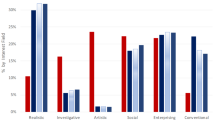Abstract
In light of the growing interest in industries as distinct units in the structure of stratification, this research explores the dimensions underlying the social evaluation of industries, with an emphasis on the meaning of industrial prestige. The data collected for this purpose consist of multiple ratings of the banking and insurance industries by a national sample of Israelis. The empirical findings indicate, first, that there exists virtual concensus about all the ratings across various demographic and socioeconomic categories and, second, that industrial prestige is related to instrumental rather than normative considerations of industrial behavior. These results are discussed in terms of the specific characteristics of banking and insurance as well as in terms of the general debate over the meaning of prestige scales of occupations.
Similar content being viewed by others
References
E.M. Beck, P.M. Horan and C.M. Tolbert (1978). Stratification in a Dual Economy: A Sectorial Model of Earnings Determination. American Sociological Review, 43(5): 704–720.
I.E. Berg (ed.) (1981). Sociological Perspectives on Labor Markets. New York: Academic Press.
R. Bibb and W. Form (1977). The Effects of Industrial, Occupational, and Sex Stratification on Wages in Blue-Collar Markets. Social Forces, 55: 974–996.
P.M. Blau, and O.D. Duncan (1967). The American Occupational Structure. New York: J. Wiley.
A.P.M. Coxon and C.L. Jones (1978). The Images of Occupational Prestige. New York: St. Martin's Press.
J.A. Dalton and E.J. Ford Jr. (1977). Concentration and Labor Earnings in Manufacturing and Utilities. Industrial and labor Relations Review, 3(1): 45–60.
O.D. Duncan, D.L. Featherman and B. Duncan (1972). Socioeconomic Background and Achievement. New York: Seminar Press.
D.L. Featherman and R.M. Hauser (1978). Opportunity and Change. New York: Academic Press.
J.A. Goldthrope and K. Hope (1974). The Social Grading of Occupations: A New Approach and Scale. Oxford, England: Clarendon Press.
R.M. Hauser and D.L. Featherman (1977). The Process of Stratification: Trends and Analysis. New York: Academic Press.
R. Hodson (1983). Corporate Economic Structure and Workers' Earnings. New York: Academic Press.
R. Hodson and R.L. Kaufman (1982). Economic Dualism: A Critical Review. American Sociological Review, 47(6): 727–732.
R.L. Kaufman, R. Hodson and N.D. Fligstein (1981). Defrocking Dualism: A New Approach to Defining Industrial Sectors. Social Science Research, 10(1): 1–31.
J.R. Kimberly (1976). Organizational Size and the Structuralist Perspective: A Review, Critique, and Proposal. Administrative Science Quarterly, 21: 571–597.
E. Laggart (1980). The Status Ranking of Industries. Journal of Management Studies, 17(1): 56–67.
Y. Samuel and E. Yuchtman-Yaar (1979). The Status and Situs Dimensions of Occupational Attractiveness. Quality and Quantity, 13: 485–501.
W.H. Sewell and R.M. Hauser (1975). Education, Occupation, and Earnings: Achievement in Early Career. New York: Academic Press.
S. Spilerman (1977). Careers, Labor Market Structure, and Socioeconomic Achievement. American Journal of Sociology, 83: 551–593.
R.M. Stoltzenberg (1975). Education, Occupation and Wage Differences between White and Black Men. American Journal of Sociology, 81: 299–323.
D.M. Tolbert, P.M. Horan and E.M. Beck (1980). The Structure of Labor-Market Segmentation: A Dual Economy Approach. American Journal of Sociology, 85: 1095–1116.
D.J. Treiman (1977). Occupational Prestige in Comparative Perspective. New York: Academic Press.
E. Yuchtman-Yaar and V. Kraus (1986). The Prestige Rating of Industries. Unpublished Report.
Author information
Authors and Affiliations
Rights and permissions
About this article
Cite this article
Yuchtman-Yaar, E., Shenkar, O. The meaning of industrial prestige. Qual Quant 21, 409–423 (1987). https://doi.org/10.1007/BF00172566
Issue Date:
DOI: https://doi.org/10.1007/BF00172566




